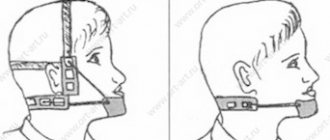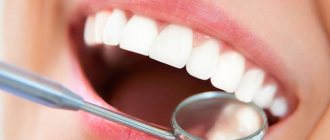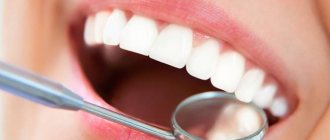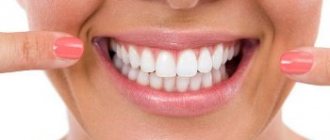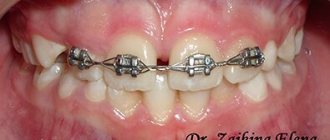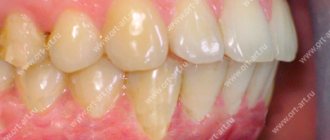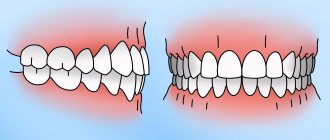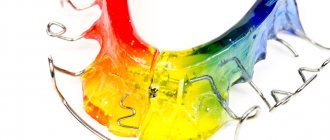Genetic predisposition
Many problems with bite and teeth in general are inherited from parents. This factor cannot be influenced. But if you know about it, you can take it into account and plan treatment in time.
If parents have had or have problems with bite, the child should be taken to an orthodontist at the age of 2–2.5 years, when all the baby teeth grow in. As the primary occlusion develops, future problems may be noticed.
Dental health is partly determined genetically
Celebrities have uneven teeth
Despite their publicity and considerable wealth, some celebrities do not strive for the perfect smile. Keira Knightley sets an example of integrity: she categorically refuses to correct her bite and uneven lower teeth. The actress claims that this does not affect her demand for films. Kirsten Dunst considers uneven front teeth to be her highlight and is also in no hurry to see an orthodontist. Steve Buscemi demonstrates miracles of self-confidence. He sincerely believes that he would cease to be himself if he decided to correct his uneven teeth. Eva Longoria also has no plans to correct her uneven lower front teeth, although it would seem that this woman definitely strives to be perfect in everything. But no, a standard smile is not her choice!
Improper development of the dental system
This is a problem for our entire civilization. The fact is that in the distant past, people ate very coarse, hard food. And his dental system functioned 100%, so it developed correctly. Modern man mainly eats freeze-dried, soft food. Sandwiches, mashed potatoes, and sausages do not require long chewing. Teeth do not receive the functional load for which they are designed. Although there are still 32 teeth, the jaw bones themselves do not develop sufficiently. Therefore, crowding and other dental abnormalities often occur.
Sometimes parents feed their child soft, crushed food for too long and do not teach him to chew. After one year, solid foods should gradually appear in children's diets. Then the teeth receive sufficient load and the jaws develop.
The child must gradually become accustomed to solid foods so that the teeth receive stress.
Negative consequences of crooked teeth
Inflammatory processes of teeth
It is important to understand that in places where teeth are crowded, the most favorable areas are created for the concentration and proliferation of pathogenic microorganisms. Even an experienced dental hygienist is often unable to clean hard-to-reach areas. That is why the presence of crooked teeth often becomes one of the factors contributing to the development of inflammatory processes.
Periodontal disease and premature tooth loss
It is also worth noting that crooked teeth prevent the uniform and correct distribution of the natural load on the dentition. As a result, some groups of teeth take on increased load from the masticatory muscles, while others receive less of it. Incorrect distribution of the load entails atrophy of certain areas of the periodontium, the development of periodontal disease, loosening and premature loss of teeth.
Pathology in the functioning of the gastrointestinal tract
Incorrect load distribution also leads to a decrease in the functional efficiency of the dentofacial apparatus. As a result, insufficiently chewed food constantly ends up in the human stomach. The digestive system begins to work intensively, which ultimately leads to the appearance of various malfunctions and pathologies in the functioning of the gastrointestinal tract.
Early loss of baby teeth
It is a common myth that baby teeth have no roots. Of course, they have roots, otherwise the teeth could not stay in the gums and perform the function of chewing. When the time comes for them to fall out, the roots of baby teeth gradually dissolve. Therefore, teeth fall out on their own easily and painlessly or are removed with little effort.
Lost milk tooth: the root is gone
But if a child’s baby tooth is removed prematurely, the neighboring teeth, whether baby or permanent, tend to occupy the “vacant” place. They bend and move. A prerequisite is created for crooked teeth growth. It turns out that by the time a permanent tooth needs to erupt, there is not enough space for it. Then it erupts with effort or moves neighboring teeth, or takes an incorrect position.
In addition, early removal of the roots of baby teeth makes it more difficult for the child to chew. He unconsciously begins to chew only on one side, unevenly loading his teeth. This can also contribute to improper formation of the jaw bones.
When are crowns used to straighten teeth?
If it is impossible to correct the crooked teeth with veneers, the doctor may offer the patient treatment using crowns. Like veneers, crowns can straighten one or more teeth.
They are usually installed on the front teeth. At the same time, dentures can restore teeth not only from an aesthetic point of view - with the help of crowns, functionality and anatomical shape are restored to damaged teeth.
It is important that the material for crowns is selected correctly - this will preserve the aesthetics of the teeth, and the installed structure will look natural, without causing discomfort to the patient. The best option is all-ceramic crowns. They best meet aesthetic requirements and, in terms of transparency and color, closely match natural teeth.
However, if you have a massive jaw, installing such crowns is not recommended. In this case, ceramic crowns, the frame of which is made of zirconium dioxide, are more suitable. If the smile area is subject to correction, then you should abandon metal-ceramic crowns, since they do not look entirely aesthetically pleasing.
Insufficient attention (from parents) during the period of occlusion change
Sometimes baby teeth fall out, on the contrary, too late. The permanent ones are already erupting, but the milk ones are still preserved. Parents bring their child to the doctor with the words: “My child’s teeth are erupting in two rows.” In such a situation, the permanent tooth erupts in the wrong position.
These little “sharks” sometimes come to the doctor
Moreover, you can immediately remove the delayed milk teeth, but the position of the permanent teeth will not improve on its own.
Crowns
Quite an affordable option. Modern dentistry offers crowns made of various materials: metal, ceramics, plastic, zirconium, and their combinations. It is advisable to install a crown if a crooked tooth is severely damaged by caries and its upper part does not look at all aesthetically pleasing.
| Advantages | Flaws |
|
|
If your teeth are growing abnormally, it is best to consult with a specialist before choosing one option or another. Each method has its pros and cons. To determine the most appropriate method of correcting the bite, it is worth undergoing an examination, since the choice of an orthodontic appliance directly depends on the specific situation.
Wisdom teeth
Although they are called “wisdom teeth,” they often show themselves to be anything but wise. The reason for this has already been mentioned - underdevelopment of the dental system. That is, wisdom teeth do not have enough space in the dentition. But they have great potential for teething. Therefore, they begin to move and shift the teeth located in front.
This picture most often appears after the age of twenty, when wisdom teeth come into their own. What does the patient say: “You know, until I was 20–25 years old, I had perfectly straight teeth. But I noticed that my wisdom teeth were starting to emerge, and now my front teeth were sharply crooked.” Removing wisdom teeth will also no longer help, because the gradually moving teeth have become accustomed to the new position.
When wisdom teeth erupt, even the incisors can move
Correcting crooked teeth with veneers
In some cases, crooked teeth can be straightened with veneers. The doctor may suggest aesthetic correction if there is slight overlap of the front teeth and there is a diastema between the front teeth. Porcelain veneers and lumineers are more suitable for correcting crooked teeth with veneers. The designs are reliable and aesthetically attractive.
The latest patented development of veneers without grinding teeth straightens small curvatures without damaging the enamel, without pain and anesthesia.
If you need to correct small curvatures and gaps, then composite veneers are quite suitable. Speaking about the price of linings, it can be noted that composite ones are cheaper than ceramic ones. Although, along with their availability, they have some disadvantages. Depending on the situation, it is possible to install a veneer on one tooth unit or on several at the same time. However, veneers are typically used to straighten front teeth.
In some cases, aesthetic restoration is aimed at improving the aesthetics of teeth, and veneers are practically the only option to correct dental defects.
Very often, crowns and veneers are used to straighten teeth that have already been treated or restored. Also, these orthodontic structures are an alternative to long-term treatment using braces and aligners. After all, thanks to the installation of veneers, you can quickly eliminate the crookedness of your front teeth, getting a beautiful and attractive smile. And in the case of braces, the treatment process requires a lot of time and patience.
Of course, composite veneers can replace braces. Moreover, they are cheaper, but composite materials can only correct crooked teeth. This leaves your original teeth color. And if we are talking about the aesthetics of a smile, then veneers and lumineers allow you to make the smile more beautiful, the one that was given to you by nature.
It’s impossible to say unequivocally that braces or veneers are better. Everything should be considered on an individual basis, taking into account the complexity and characteristics of the situation during an in-person examination by a doctor.
Somatic diseases
A very important point is the health of the ENT organs. Impaired nasal breathing is a significant risk factor in orthodontics.
One of the common problems in children is adenoids. This is a pathological proliferation of glandular tissue for a number of reasons: decreased immunity, predisposition. As a result, the child cannot breathe through his nose because it is constantly blocked. Habitual mouth breathing is formed.
And for the normal development of the upper jaw, nasal breathing is necessary. If this does not happen, it narrows, causing the teeth to move into the wrong position. Moreover, the correct closure of the upper and lower jaws is disrupted, and an abnormal bite develops.
Correct bite: what it looks like
A person’s bite is formed until the baby teeth are completely replaced by permanent teeth. To determine whether your bite is correct or incorrect, you need to be in a calm and relaxed position, with your jaws naturally closed. To get your teeth into the right position: you need to make a swallowing movement and simply close your teeth. Next you need to examine your teeth and pay attention to the following points:
Position of incisors. With a correct bite, the upper incisors should overlap the lower ones by one third. The degree of closure should be tight;
Fangs and incisors should be located in a straight line, in which there should be no cracks or distortions;
The teeth of the upper row should protrude slightly forward, towards the lips, and the molars should be strictly under each other.
Below we post a photo that will help you understand what a correct teeth bite looks like. However, we do not recommend self-diagnosis based on this photo: only a specialist can determine whether your dental bite is correct or incorrect. Not all bite defects manifest themselves clearly and sometimes they can only be identified after a series of diagnostic measures.
Musculoskeletal problems
This has already been noted in a fairly large number of scientific publications: if a patient has a malocclusion, then in almost 90% of cases there are problems with the temporomandibular joint (TMJ), and therefore with the back in various parts of the spine: cervical, thoracic, lumbar .
When the spine is curved, the lower jaw also shifts
The fact is that all ligaments and muscles in the body work harmoniously. If there is asymmetry or overstrain somewhere, compensation immediately occurs due to other muscles. Any displacement of the jaw leads to a violation of the position of the head; Incorrect tilt of the head leads to curvature of the spine in the cervical region, and so on. And vice versa. Slouching leads to a constant tilt of the head forward, which is why the lower jaw can move back, and a pathological bite is formed.
There are studies confirming that the condition of the feet affects the bite! Flat feet are one of the factors in the development of pathologies of the dental system. Therefore, during orthodontic treatment, we often recommend that patients also see an orthopedist or surgeon and undergo comprehensive treatment to avoid relapse in the future.
Methods for correcting bite
When identifying a problem, the question arises: how to fix uneven teeth?
This problem can be solved even at a serious stage. Orthodontic treatment can be performed at any age. Modern orthodontics has a whole arsenal of ways to solve this problem.
The first examination should be carried out on a child at 3 years old to identify temporary malocclusion. At this age, treatment is not carried out. You can prescribe special exercises that will help eliminate the pathology. If a child has uneven teeth, then treatment can begin no earlier than 6-7 years, when the patient has permanent teeth.
Correcting the bite is also possible in later years, but the sooner this is done, the fewer problems a person will encounter, the closer to the ideal the result will be.
Young children can use removable devices. At a later age, various correction methods are used. The most effective of them is permanent fixed braces. The treatment aims to correct malocclusion – the pathological position of the jaws.
The principle of their influence is constant pressure on the teeth in the direction of their optimal location. Braces eliminate both crowding of teeth and the opposite pathology – interdental spaces.
The main advantage of braces is their versatility: in the absence of age restrictions, a positive result is guaranteed. Another positive point is the speed of achieving the goal - from six months.
Alternative methods to traditional braces are:
- Options with artificial sapphires;
- Orthodontic devices with ceramic elements;
- Lingual braces, which are placed on the inner surface of the teeth.
After eliminating the problem, retainers should be worn for some time to consolidate the results.
The use of braces is limited to a number of indications:
- Diseases of bone tissue and blood;
- Pathologies of the heart and endocrine system;
- Oncological processes;
- Tuberculosis;
- HIV infection.
Bruxism
Bruxism is a paroxysmal contraction of the masticatory muscles, or grinding of teeth during sleep. In most cases, this disorder occurs in children. Stress is considered the main cause of bruxism. In general, bruxism occurs to one degree or another in most people. But if severe, bruxism can cause a lot of dental problems, so you should definitely consult a doctor.
Bruxism is a reason to see a doctor
How to straighten teeth for an adult
If you think that an overbite is just unsightly, then you are mistaken. The anomaly is dangerous due to the uneven distribution of the chewing load. When chewing food, not only the dentition, but also the joints collapse.
To stay healthy and look good, you should not delay orthodontic treatment. Our clinic’s orthodontists install correction systems for patients of any age. The doctor, together with the patient, selects the correction method.
Basic methods of orthodontic treatment in adults:
Fixed structures
The most common correction method is to correct the bite using a braces system. They help correct pathologies of varying degrees. Even the heaviest ones. Fixed structures successfully cope with problems of the oral cavity, both physiological and aesthetic.
Our clinic uses different types of structures. For example, lingual or sapphire vestibular braces can be installed on the upper jaw. Visually they are invisible.
Combined treatment
If there are severe skeletal disorders and bite deformities, then the professional knowledge and skills of an orthodontist and surgeon are required. Doctors create a comprehensive treatment plan, which includes jaw surgery and correction with braces.
Correction with aligners, veneers, lumineers
Veneers are used to correct the anterior row. The downside of the structures is the need to grind down your own healthy teeth. Lumineers fit tighter and look more natural. There is no longer any need to endure discomfort from braces. Aligners are used to correct simple dental anomalies. They are smooth, transparent, and cannot be seen. This gentle correction method can completely replace braces.
The result of treatment does not depend on age. An experienced orthodontist will make your smile perfect, no matter your age. At the Propricus clinic they know everything about how to correct crooked teeth without pain. During the consultation, the doctor will select possible treatment options and tell you about the duration of the correction. Next, the decision is yours.
Sign up for free 3D modeling of your future smile!
Make an appointment
*By making an appointment you consent to the processing of your data
What is the best way to correct the position of teeth?
We have listed the main reasons why teeth grow uneven. How can we fix them? Braces are an effective and well-proven method of treating any malocclusion. But they are not comfortable for all people, and not everyone wants to wear a fixed structure on their teeth.
An alternative is aligners - transparent, removable aligners made of polymer material. They have the same effectiveness as braces, but wearing comfort is incomparably higher.
In terms of speed of bite correction, aligners show themselves to be on par with modern non-ligature braces. And in some cases they work even faster. For many patients, it is enough to wear aligners for only 8-10 months. Moreover, if the patient follows the recommendations, the result remains for life.
Uneven teeth - BEFORE and AFTER photos
Australian star Delta Goodrem decided to correct her uneven teeth and was right – after treatment, her career began to develop rapidly.
Madonna's daughter Lourdes had quite noticeable uneven teeth. However, she did not follow her mother’s example in refusing treatment and got braces.
Tom Cruise is the most striking example of a person who values the importance of a beautiful smile and decided to undergo orthodontic treatment, not being embarrassed to wear braces as an adult man. Better late than never!
We hope that all these celebrities are not destined to face any unpleasant health consequences, and uneven teeth will remain just an original feature of their image.
Publisher: Expert magazine about dentistry Startsmile.ru
Dystopia: heredity and external factors
A common cause of malocclusion is dystopia - incorrect placement of teeth in a row. They can be shifted towards the vestibule of the mouth, cheeks, or rotated by a certain degree around their own axis. In a wide range of cases, this individual feature is genetic in nature: a person “inherits” a narrow, small jaw on one parental line, and rather large teeth on the other, which, with the growth and development of the body, leads to some displacement of the teeth in their dense row. Violations of the child’s hormonal levels can also lead to similar changes. External risk factors for the appearance of uneven teeth are:
- features of the mother’s pregnancy (use of certain medications, possible infections, etc.);
- pathology of the facial nerves and masticatory muscles;
- unsatisfactory environmental conditions in the child’s place of residence;
- certain habits at an early age (sucking pacifiers, fingers, etc.);
- loss of baby teeth in early childhood;
- anatomical features of the oral cavity (for example, short frenulum).

